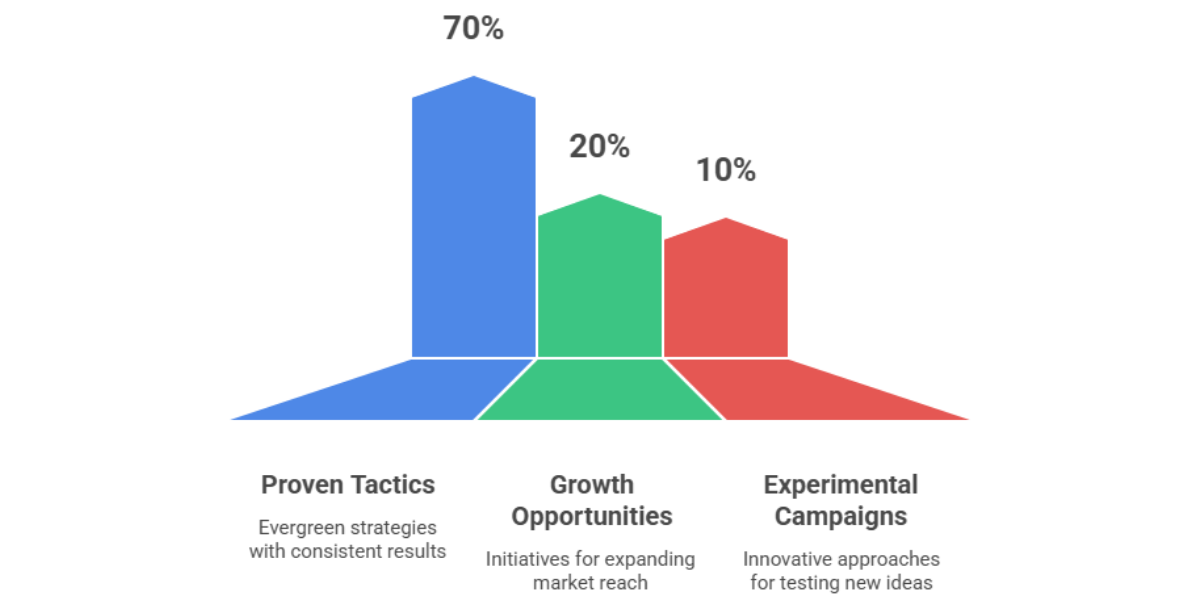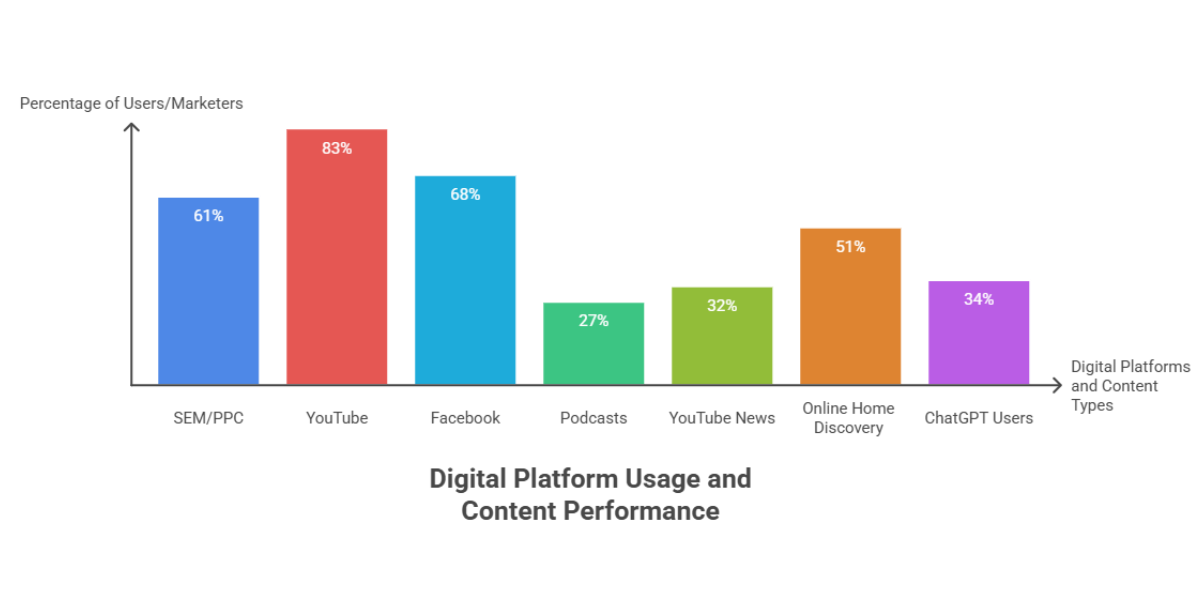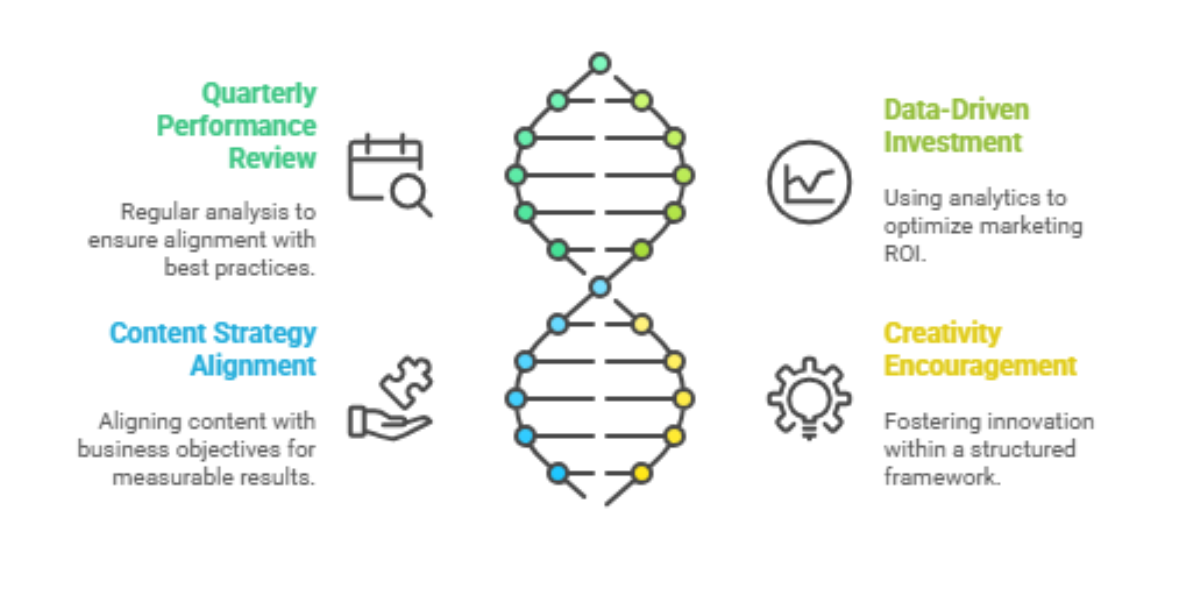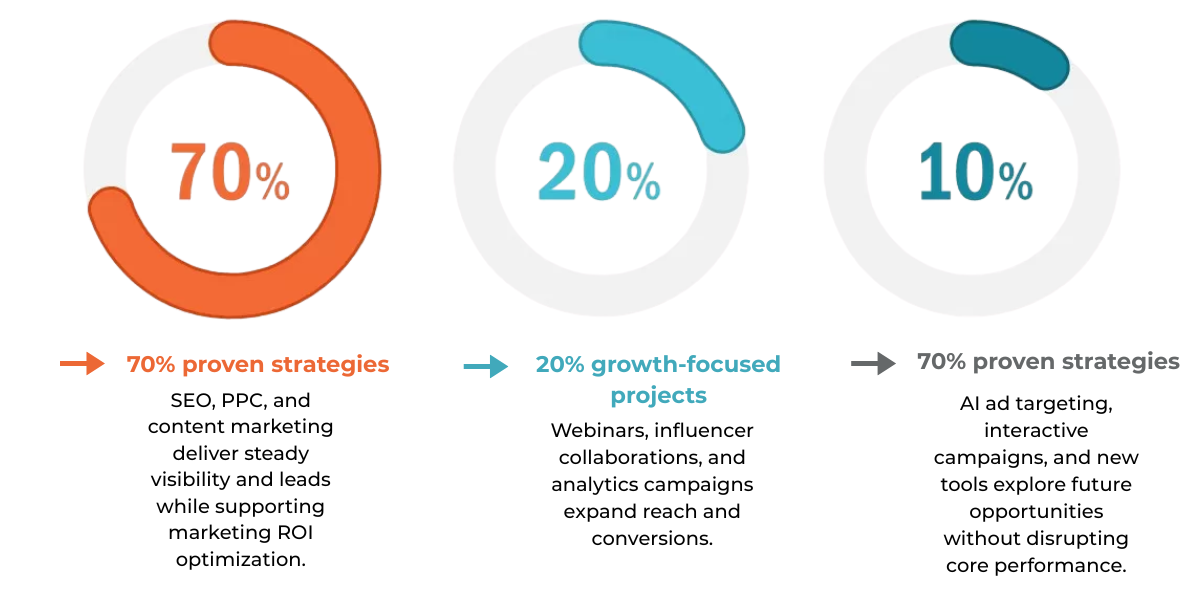Balancing ROI-driven marketing efforts with fresh ideas can be challenging for many businesses. Small and mid-sized companies, from B2B service providers to e-commerce brands and local service industries, often face uncertainty in allocating their marketing budgets effectively. The 70:20:10 rule marketing framework offers a structured way to guide digital marketing strategies, optimize ROI, and embrace innovation without losing focus on proven tactics.
This article explains the digital marketing strategy framework behind the 70:20:10 rule, its practical applications, and how to use it for measurable business growth.
What is the 70:20:10 Rule in Marketing?

The 70:20:10 model helps businesses split marketing efforts into predictable, growth-oriented, and experimental activities. It allocates:
- 70% to proven, evergreen tactics
- 20% to growth opportunities
- 10% to experimental and innovative campaigns
This model fits content marketing, advertising, and a broader marketing mix strategy. It keeps businesses grounded while leaving space for creativity and new approaches.
Talk About Your Marketing Budget With Expert
What is the 70:20:10 Strategy in Digital Marketing?
For small and mid-sized businesses (SMBs), this digital marketing strategy framework keeps budgets balanced. The 70:20:10 rule of marketing means:
- 70% goes to channels like SEO, PPC, email marketing, and evergreen content.
- 20% funds are promising campaigns such as webinars and thought leadership projects.
- 10% test innovative tools like AI or emerging platforms.
This structure ensures steady ROI while supporting innovation in manageable steps.
Benefits of the 70:20:10 Rule
The content marketing 70 20 10 rule brings multiple benefits:
- Predictability: Core tactics like SEO and PPC provide steady leads and revenue, forming the base for marketing ROI optimization.
- Clarity: A clear content mix strategy separates proven tactics from growth ideas, helping businesses plan with confidence.
- Efficiency: Tracking and refining campaigns cut wasted ad spend, leaving room for innovative marketing ideas.
- Growth potential: New experiments uncover opportunities for competitive advantage and long-term success.
Organizing digital marketing investment priorities this way prevents wasted budgets and supports growth.
Breakdown of the 70:20:10 Content Mix

The 70:20:10 rule marketing creates a balanced content plan combining proven strategies, growth efforts, and experimental ideas.
70% Proven Content
Evergreen content planning drives steady traffic, leads, and sales. Examples include:
- Blog posts optimized for SEO: Long-form content built around strategic keywords strengthens visibility and supports digital marketing best practices.
- Email newsletters: Regular updates build audience relationships and support content marketing efforts.
- Local SEO campaigns: Location-based keywords and Google Business Profile optimization help businesses reach nearby customers effectively.
- Google Ads and PPC campaigns: Paid campaigns deliver quick visibility while allowing precise ROI optimization.
The goal is steady, consistent growth through reliable channels.
Among paid channels used to distribute content, SEM/PPC is rated best performing by 61% of B2B marketers.
20% Premier Content
High-value, engaging content builds authority and trust:
- Expert interviews: Industry insights strengthen content marketing strategy and audience confidence.
- Long-form guides: Comprehensive resources align with digital marketing investment priorities for lasting results.
- Thought leadership blogs: Trend analysis positions brands as leaders within the social media strategy framework.
- Webinars or virtual events: Interactive formats support marketing mix strategy while generating quality leads.
According to the report, on the platform reach that shapes marketing mix choices, 83% of adults report using YouTube, and 68% use Facebook. 27% of adults at least sometimes get news from podcasts, making expert interviews and long-form educational audio content a viable reach play.
Roughly a third of adults regularly get news on YouTube (32%), supporting webinar-style video and authority-building series.
10% Experimental Content
A small share of resources supports innovation:
- AI-driven personalization: Tailored experiences enhance engagement and align with the digital marketing strategy framework.
- TikTok campaigns: Creative short-form videos expand reach through the social media strategy framework.
- Interactive content formats: Polls and quizzes boost audience participation while testing innovative marketing ideas.
- AR/VR marketing experiences: Immersive campaigns support marketing experiments and innovation for future growth.
51% of recent home buyers discovered the home they bought online, which is a solid example to consider when discussing Local SEO and how visible listings are. 17% of adults regularly get news on TikTok (up from 3%), signaling a clear testing ground for short-form experiments. 34% of adults say they have ever used ChatGPT, according to a Pew Research Center survey. That includes a 58% majority of adults under 30. Still, 66% have not used the chatbot, including 20% who say they’ve heard nothing about it.
Talk About Your Marketing Budget With Expert
How to Apply the 70:20:10 Rule to Your Digital Marketing
Businesses can follow clear steps to apply the content marketing 70 20 10 rule effectively.
Step 1 – Prioritize Core Activities (70%)
Dedicate most resources to evergreen tactics like SEO, PPC, and email campaigns. Examples include:
- Running Google Ads targeting local audiences: Local PPC campaigns deliver targeted leads while supporting ROI optimization.
- Creating SEO-optimized blog posts: Keyword-focused content strengthens rankings and long-term visibility.
- Publishing weekly newsletters: Regular outreach builds trust and supports digital marketing best practices.
Step 2 – Allocate for Growth (20%)
Growth efforts expand reach and build engagement:
- A/B testing ad creatives: Controlled experiments identify high-performing campaigns within the marketing mix strategy.
- Influencer partnerships: Collaborations strengthen content marketing strategy while aligning with digital marketing investment priorities.
- Content syndication: Sharing across platforms amplifies content visibility and brand reach.
Step 3 – Embrace innovation (10%)
Innovation introduces new tactics without disrupting core efforts:
- Chatbot-driven lead generation: Automated interactions improve customer engagement and align with the social media strategy framework.
- AI-powered ad targeting: Data-driven targeting boosts ROI while supporting marketing experiments and innovation.
- VR product demos or virtual tours: Immersive experiences showcase offerings creatively and effectively.
Step 4 – Maintain Balance
Budgets need regular reviews to stay effective. Quarterly adjustments based on results ensure resources support digital marketing best practices while leaving room for innovative marketing ideas and new opportunities.
Industry-Specific Applications of the 70:20:10 Rule
Industries apply the digital marketing strategy framework differently based on goals and audiences.
B2B Service Providers & Agencies

- 70%: LinkedIn articles, case studies, and email campaigns form the base for B2B marketing strategies within a digital marketing agency.
- 20%: Webinars, whitepapers, and guest posts deepen expertise and attract targeted leads.
- 10%: AI chatbots, podcasts, and experimental content introduce innovative marketing ideas for future growth.
E-commerce Brands

- 70%: SEO product pages, retargeting ads, and email campaigns form the foundation of e-commerce marketing strategies.
- 20%: Influencer collaborations and user-generated content expand reach and trust.
- 10%: AR try-ons, gamified shopping, and TikTok ads keep strategies fresh with innovative marketing ideas.
Real Estate, Healthcare, Legal, and Local Services

- 70%: Local SEO, referral marketing, and Google Business Profile optimization maintain visibility.
- 20%: Client webinars and landing page testing improve conversions and audience education.
- 10%: Community platforms, niche ads, and VR tours diversify outreach within the marketing mix strategy.
9% of home buyers completed purchases based only on a virtual tour/showing/open house, evidence that immersive formats (AR/VR) can influence real decisions.
Digital Marketing Best Practices with the 70:20:10 model

- Review marketing performance quarterly: Regular analysis ensures alignment with digital marketing best practices.
- Use analytics for digital marketing investment priorities: Data-driven decisions improve marketing ROI optimization.
- Align content strategies with business goals: A content mix strategy keeps efforts connected to measurable objectives.
- Encourage creativity within the framework: Brainstorming and pilot projects maintain consistency while supporting evergreen content planning.
Talk About Your Marketing Budget With Expert
Common Mistakes to Avoid
- Over-investing in risky experiments: Budgets should limit marketing experiments and innovation to protect ROI.
- Neglecting proven 70% strategies: Reliable tactics form the base of any marketing mix strategy.
- Failing to track ROI across campaigns: Measurement enables marketing ROI optimization and smarter spending.
- Treating allocations as rigid: Budgets should evolve with performance data and trends.
Related Digital Marketing Frameworks to Know
- The 7 C’s of Digital Marketing: Content, Context, Community, Convenience, Cohesion, Conversion, and Customization support a complete content mix strategy.
- The 5 P’s of Digital Marketing: Product, Price, Place, Promotion, and People form the foundation of marketing mix strategy and complement the 70:20:10 model.
How We Apply the 70:20:10 Rule at SpreadMe Digital

At SpreadMe Digital, we help micro, small, and medium-sized businesses apply the digital marketing strategy framework for measurable growth.
- 70% proven strategies: SEO, PPC, and content marketing deliver steady visibility and leads while supporting marketing ROI optimization.
- 20% growth-focused projects: Webinars, influencer collaborations, and analytics campaigns expand reach and conversions.
- 10% innovative experiments: AI ad targeting, interactive campaigns, and new tools explore future opportunities without disrupting core performance.
Our clients gain consistent visibility, lead generation, and ROI through this structured approach, making SpreadMe Digital a trusted partner for long-term success.
Final Thoughts
The 70:20:10 rule marketing model gives businesses a clear, practical framework for steady growth, innovation, and ROI optimization. It balances reliable strategies with opportunities for experimentation, ensuring measurable results while keeping budgets under control.
Contact SpreadMe Digital today to see how this model can guide your marketing efforts and help your business achieve lasting success.
FAQs on the 70:20:10 Rule in Marketing
What is the 70-20-10 strategy in digital marketing?
- It is a digital marketing strategy framework allocating 70% to proven tactics, 20% to growth, and 10% to experiments for balanced ROI and innovation.
What is the 70-20-10 rule in business overall?
- It applies to leadership development and corporate innovation, balancing learning, experience, and experimentation.
What is an example of the 70-20-10 rule?
- An e-commerce brand might use 70% for SEO and ads, 20% for influencer campaigns, and 10% for AR shopping experiences.
How does it work in practice?
- Budgets get a thorough review every three months, we keep an eye on ROI, and we make necessary tweaks based on how things are performing and any shifts in the market.
What are the benefits of using this rule?
- It focuses on spending, reducing waste, supporting long-term growth, and encouraging adaptability.




